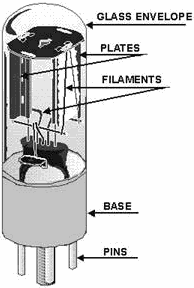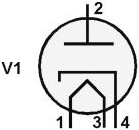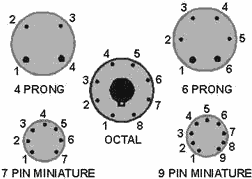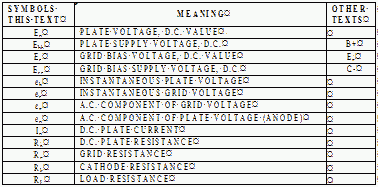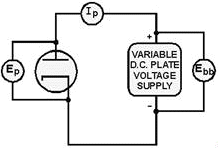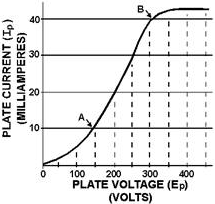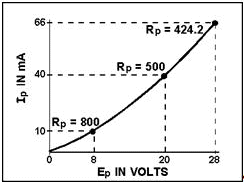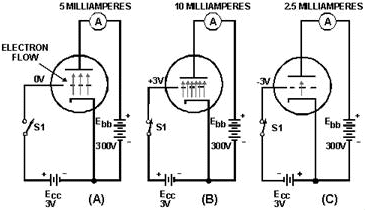Module 6 - Introduction to Electronic Emission, Tubes, and Power Supplies
Navy Electricity and Electronics Training Series (NEETS) |
||||||||||||||||||||||||||||||||||||||||||||||||||
|
Module 6 − Introduction to Electronic Emission, Tubes, and Power Supplies Pages i, 1−1, 1−11, 1−21, 1−31, 1−41, 1−51, 2−1, 2−11, 2−21, 2−31, 3−1, 3−11, 3−21, 3−31, 3−41, 3−51, AI−1, Index
Figure 1-9. - Diode construction.
The base must be mechanically strong and made of an insulating material to prevent the tube elements from shorting.
Because they require relatively frequent replacement, most tubes are designed to plug into sockets permanently mounted in the equipment. Tube pins and sockets are so designed that tubes cannot be plugged in incorrectly.
Tube sockets must make secure mechanical and electrical contact with tube pins, must insulate pins from each other, and must provide terminals to which circuit components and conductors are connected.
Each element of a tube is connected to a pin in its base. To trace a circuit easily and efficiently, you must match elements with their pin numbers. This information is available in tube manuals and equipment schematics. Figure 1-10 shows these numbers on one example of a diode symbol. You will also note the designation V1 beside the tube. Electron tubes are often identified in schematic diagrams by the letter V and a number.
Figure 1-10. - Identification of tube elements.
Now, to use the information in the symbol, you need to know the system used to number tube pins and socket connections.
Figure 1-11 shows five common pin configurations as viewed from the bottom of each tube or socket. This is important. In every case, pins and pin connections on sockets are numbered in a clockwise direction - When VIEWED FROM The BOTTOM.
Figure 1-11. - Pin Identification; all tubes are viewed from the bottom.
In each of the five pictures in figure 1-11, there is an easily identified point from which to start numbering. In the 4-prong and 6-prong tubes, the point is between the two larger prongs. In the octal tube, the point is directly down from the keyway in the center of the tube. In the 7-pin and 9-pin miniatures, the point is identified by the larger distance between pins.
Q9. Name two functions of the base of a vacuum tube.
The Envelope
The envelope of a tube may be made of ceramic, metal, or glass. Its major purpose is to keep the vacuum in and the atmosphere out. The main reason for this is that the heated filament would burn up in the atmosphere. There are other reasons for providing a vacuum, but the important thing is to realize that a tube with a leaky envelope will not function properly.
The silver spot you will sometimes see on the inside surface of the glass envelope of a vacuum tube is normal. It was caused by the "flashing" of a chemical during the manufacture of the tube. Burning the chemical, called the GETTER, helps to produce a better vacuum and eliminates any remaining gases.
ELECTRICAL PARAMETERS of DIODES
Thousands of different tubes exist. While many of them are similar and even interchangeable, many have unique characteristics. The differences in materials, dimensions, and other physical characteristics, such as we have just covered, result in differing electrical characteristics.
The electrical parameters of a diode, and any tube, are specific. In the process of discussing these parameters, we will state exact values. Voltages will be increased and decreased and the effects measured. Limiting factors and quantities will be explored and defined. The discussion will be based on simplified and experimental circuits.
It is important for you to realize that practically all of the parameters, limitations, definitions, abbreviations, and so on that we will cover in these next paragraphs will apply directly to the more complex tubes and circuits you will study later. Diode parameters are the foundation for all that follows.
Symbols
You have learned to use letters and letter combinations to abbreviate or symbolize electrical quantities. (The letters E, I, and R are examples.) We will continue this practice in referring to tube quantities. You should be aware that other publications may use different abbreviations. Many attempts have been made to standardize such abbreviations, inside the Navy and out. None have succeeded completely.
Table 1-1 lists electron-tube symbols used in the remainder of this chapter. The right-hand column shows equivalent symbols that you may find in OTHER texts and courses.
Table 1-1. - Symbols for Tube Parameters
Plate Voltage-Plate Current Characteristic
You know that a positive voltage on the diode plate allows current to flow in the plate circuit. Each diode, depending on the physical and electrical characteristics designed into the diode, is able to pass an exact amount of current for each specific plate voltage (more voltage, more current-at least to a point).
The plate voltage-plate current characteristic for a given diode is a measure of exactly how much plate voltage controls how much plate current. This is often called the Ep - Ip characteristic.
The Ep - Ip characteristic for a given diode, is determined by design engineers using mathematical analysis and laboratory experiment. You, as a technician, will never need to do this. However, you will use the results obtained by the engineers. You will also use your knowledge of the diode as you analyze equipment malfunction.
Assume that we have the circuit in figure 1-12. (The filament has the proper voltage-even though it isn't shown on the diagram.) Our purpose is to determine just how a changing voltage on the plate changes (or controls) the plate current. The method is as follows:
Figure 1-12. - Determining diode plate characteristic.
1. Starting with zero volts from our variable dc voltage source, increase the plate voltage (Ep) in steps of 50 volts until you reach 400 volts.
2. At a each 50-volt step, measure the milliamperes of plate current (Ip) that flow through the meter. Record the Ip meter readings, step by step, so that you may analyze the results.
Assume that table 1-2 shows our results. While we could use the table, a more normal procedure is to plot a graph of the values. Such a graph is called an Ep - Ip Curve and is shown in figure 1-13. Each tube has its own Ep - Ip curve, which is available in commercial tube manuals and in many equipment technical manuals. Each curve will be different in some respects from every other curve. The shapes, however, will be similar.
Table 1-2. - Ep - Ip Values Obtained by Experiment
Figure 1-13. - Ep - Ip characteristic curve.
The Ep - Ip curve in figure 1-13, although just an example, is typical of real plate characteristic curves. You may learn certain characteristics that apply to both diodes and other tubes by studying it.
First, look at the part of the curve to the left of point A. Because it is not a straight line, it is referred to as NONLINEAR. Note that a change of 150 volts (0-150) caused a change of 10 mA of plate current (0-10). In comparison with the straight-line part of the curve, between points a and B, this is a relatively small change in current. The smaller the change in current, the flatter the curve.
In explaining this NONLINEAR portion of the curve, let's go back just a bit to electron emission. The electrons emitted by a cathode form a cloud around the cathode. This cloud is called the SPACE CHARGE. The closer the space charge is to the cathode, the more densely packed it is with electrons. In our example, the lower plate voltages (0-150 volts) over this part of the curve exert a pull on only the outer fringe of the space charge where there are few electrons. This results in relatively few electrons flowing to the plate.
Now look at the center portion of the curve between a and B. This is known as the LINEAR portion because it is nearly a STRAIGHT LINE. Over this portion, a change of 50 volts Ep causes a change of 10 mA Ip.
The reason for the increased change in plate current for a given change of plate voltage also has to do with the space charge. With a higher plate voltage (over 150 volts), the attraction from the plate begins to influence the DENSER part of the space charge that has greater numbers of electrons. Therefore, a higher current flows for a given voltage than in the nonlinear part. The curve becomes steeper. In our example, this linearity continues to about 300 volts, point B.
Lastly, let's look at the top portion of the curve. The plate current plotted here is produced by the higher plate voltages. However, the amount of current change for a given voltage change is greatly reduced. The reason for this again involves the space charge. At about 300 volts, almost all of the electrons in the space charge are flowing to the plate. a higher voltage cannot attract more electrons because the cathode cannot produce any more. The point where all (or almost all) available electrons are being drawn to the plate is called PLATE SATURATION or just SATURATION. This is one of the limiting factors of every tube.
You can see from the analysis that the most consistent control of plate current takes place over the linear portion of the Ep - Ip curve. In most applications, electron tubes are operated in this linear portion of the characteristic curve.
Plate Resistance (Rp)
One tube parameter that can be calculated from values on the Ep - Ip curve is known as plate resistance, abbreviated as Rp. In a properly designed electron tube, there is no physical resistor between cathode and plate; that is, the electrons do not pass through a resistor in arriving at the plate. You may have wondered, however, why the variable dc voltage source of figure 1-12 didn't blow a fuse. Doesn't the plate circuit appear to be a short circuit-a circuit without a load to limit the current?
The fact is, there is a very real, effective Resistance between cathode and plate. It is not lumped in a resistor, but the circuit may be analyzed as if it is. The plate resistance of a given tube, Rp, can be calculated by applying Ohm's law to the values of Ep and Ip. Figure 1-14 is a typical diode Ep - Ip curve. The plate resistance has been figured for Rp under three different conditions, as follows:
Figure 1-14. - The Ep - I characteristic curve for a diode.
Remember that 1 mA = .001 ampere; therefore 40 mA =.040 ampere.
Solution:
The other two indicated values of Rp were figured in the same way.
You should note that there is very little difference in plate resistance when the Ep and Ip values are taken from the linear portions of curves. Check this out with values taken from the linear portion of figure 1-13.
Rp (with a capital R) is the effective resistance offered to direct current.
PLATE Resistance IN GAS DIODES. - Gas diodes are a type of tube that we have not yet discussed. They are mentioned here only because of their plate-resistance characteristic.
Instead of a high-vacuum environment, some tubes have small amounts of gas introduced in the envelope vacuum during manufacture. Argon, neon, helium, or mercury vapor are commonly used.
When a certain minimum voltage is placed on the plate, the gas molecules in the envelope ionize. This happens by a process that will be explained when gas diodes are studied. The positive ions tend to cancel some of the effects of the space charge that influence plate resistance in a vacuum tube. This canceling reduces internal plate resistance to a relatively low, constant value. In applications that require a large plate current, the low plate resistance of a gas-filled diode has an efficiency that cannot be approached by a high-vacuum diode.
This and other characteristics of gas tubes will be covered later.
Q10. Vacuum tubes are designed to operate in what portion of the Ep - Ip curve? Q11. What value can be calculated from the values found on an Ep - Ip curve?
Plate Dissipation
When electrons are attracted from the space charge to the plate, they are accelerated by the attraction. Their gain in speed gives them energy that causes them to strike the plate with a considerable force. As the electrons strike the plate, this energy is converted to heat. The plate must be able to withstand the associated increase in temperature. The maximum amount of power (watts) that a given plate can safely dissipate (as heat) is called the PLATE DIsSIPATION rating.
To find the amount of plate dissipation for a given tube under a particular set of plate conditions, use the following equation:
This is a relatively small wattage. It's probable that the plate of our example diode is not overheating. a tube manual could tell us for sure.
Plate dissipation is a circuit loss that must be made good by the power source in a circuit. In our example, this is the plate voltage supply.
Peak Current Rating
The maximum instantaneous current that a tube can pass in the normal direction (cathode to plate) without damage is called the PEAK CURRENT RATING. Peak current rating is determined by the amount of electrons available from the cathode and the length of time plate current flows.
Peak Voltage Rating
This is the maximum instantaneous voltage that can be applied to a tube in the normal direction without a breakdown.
Peak Inverse Voltage Rating
This is the maximum voltage that can be applied to a tube in the reverse direction (plate negative with respect to the cathode)-exceeding this will cause arc-over from the plate to the cathode and will damage the tube. PIV, as this is sometimes abbreviated, becomes very important in the rectifier circuit to be discussed as a later major subject.
Transit Time
Things that happen in electricity and electronics are often explained as if they happen instantaneously. As fast as electricity acts, however, the truth is that cause and effect are separated by a certain amount of time.
Each tube has a factor called TRANSIT TIME, which is the time required for an individual electron to move from the cathode to the plate. In certain applications involving high-frequency voltages, transit time places a limitation on tubes. We will explain this limitation when we discuss the circuits it affects.
Summary of Diode Parameters and Limitations
You should now have a basic understanding of diodes, many of their characteristics, and some of their limitations. One of the more important concepts that you should now understand is that most of these characteristics influence each other. For example, practically all plate characteristics are interrelated. Change one and the others change. Another example is heater voltage. Every tube parameter affected by the cathode depends on proper heater voltage. Interrelationships such as these make electronics both fascinating and, at times, frustrating.
Many of the limiting factors that we have discussed are the same ones found in other electrical devices such as motors, stoves, toasters, and so on. Heating and overheating, insulation breakdown, and excessive voltage and current are all limitations that you have noted before.
The point is that you can and should apply just about everything you have learned about electricity to electron tubes. Little is new except the environment.
Q12. a large negative voltage is applied to the plate of a diode, and a large positive voltage is applied to the cathode. If the tube conducts, what tube parameter has been exceeded?
The TRIODE
Diode electron tubes can be used as rectifiers, switches, and in many other useful applications. They are still used in Fleming's original application in some radio circuits. You will learn more of these
applications in other NEETS modules and later will see the diode in several pieces of electronic equipment.
As with all inventions, Fleming's diode was immediately the subject of much experimentation and many attempts at improvement. An American experimenter, Dr. Lee De Forest, added another active element to the diode in 1906. He was trying to improve the radio application of Fleming's diode. His new tube was eventually called a triode.
de Forest's triode was not very successful as a radio "detector." (Detectors will be studied in a later NEETS module.) However, in 1912, De Forest discovered that his original triode could AMPLIFY or magnify very weak electrical impulses. It is because of the triode's ability to amplify that De Forest is honored as one of the great radio pioneers.
The immediate application of the triode amplifier was in telephone and radio. Both fields were limited because electrical impulses (signals) became weaker and weaker as the distance from the signal source increased. The triode, along with other developments of the time, made long-distance communications possible. Looking back, we can now see that the amplifying tube was the real beginning of modern electronics and influenced everything that followed. Let's find out more about the idea of amplification and how it is done in the triode.
You are already familiar with a type of amplification. In a previous NEETS module, step-up transformers were discussed. You should remember that an input voltage applied to the primary of a step- up transformer is increased in amplitude at the secondary by a factor determined by the step-up turns ratio.
For example, if 5 volts were applied to the primary of a 1:3 step-up transformer, the secondary would produce 15 volts. In other words, the input voltage was amplified by a factor of 3. When applied to electronic circuits, these primary and secondary voltages are more often called signals, or input and output signal, respectively. In electronics, the amplitude of an input signal must sometimes be increased many times-often, hundreds or thousands of times!
Because of size and design limitations, transformers are usually not practical for use in electronics as amplifiers.
de Forest's first experiment with the diode was to place an additional metal plate between the cathode and plate. He then placed an ac signal on the metal plate. When the circuit was energized, De Forest found that the ammeter stayed on zero regardless of the polarity of the input signal.
What was happening was that the new element was blocking (or shadowing) the plate. Any electrons attempting to reach the plate from the cathode would hit the new element instead. As the circuit didn't work, it was back to the drawing board.
In his next attempt, De Forest decided to change the element between the cathode and the plate. Instead of a solid metal plate, he used a wire mesh. This would allow electrons to flow from the cathode, Through The Wire MESH, to the plate. This tube circuit is shown in figure 1-15. In view (A) you see De Forest's circuit with 0 volts applied to the third element, (today called a control grid or occasionally just the grid). Under these conditions, assume that the ammeter reads 5 milliamperes. With no voltage applied to the grid, the grid has little effect on the electron stream. For all practical purposes, the control grid is not there. Most electrons flow through the open mesh. The tube functions as a diode.
Figure 1-15. - de Forest's experiment.
In view (B), you see De Forest's tube with +3 volts applied to the control grid. When De Forest applied this voltage, he found that plate current, Ip, increased by a large amount. (We'll say it doubled to simplify the explanation.) You already know that the only way to double the plate current in a diode is to increase the plate voltage by a large amount. Yet, De Forest had doubled plate current by applying only 3 volts positive to the control grid!
The reason for this is fairly easy to understand. It's the old principle of "opposites attract." When the control grid was made positive, electrons surrounding the cathode (negative charges) were attracted to the grid. But remember, the grid is a metal mesh. Most of the electrons, instead of striking the grid wires, were propelled through the holes in the mesh. Once they had passed the grid, they were attracted to the positive charge in the plate.
You might wonder why the grid would make that much difference. After all, the plate has 300 volts on it, while the grid only has 3 volts on it. Surely the plate would have a greater effect on current flow than a grid with only one one-hundredth the attractive potential of the plate. But remember, in your study of capacitors you discovered that opposites attract because of electrostatic lines of force, and that the strength of electrostatic lines of force decreased with distance. In his tube, de Forest had placed the grid very close to the cathode. Therefore, it had a greater effect on current flow from the cathode than did the plate, which was placed at a much greater distance from the cathode. For this reason, De Forest was able to double the current flow through the tube with only +3 volts applied to the grid.
de Forest had certainly hit on something. Now the problem was to find out what would happen when a negative potential was applied to the grid. This is shown in view (C) of figure 1-15. When De Forest applied -3 volts to the grid, he found that plate current decreased to half of what it was when the grid had no voltage applied. The reason for this is found in the principle of "likes repel." The negatively charged grid simply repelled some of the electrons back toward the cathode. In this manner, the attractive effect of the plate was decreased, and less current flowed to the plate.
Now De Forest was getting somewhere. Using his new tube (which he called a triode because it had 3 elements in it), he was able to control relatively large changes of current with very small voltages. But! was it amplification? Remember, amplification is the process of taking a small signal and increasing its amplitude. In De Forest's circuit, the small input signal was 3 volts dc. What De Forest got for an output
|
||||||||||||||||||||||||||||||||||||||||||||||||||
